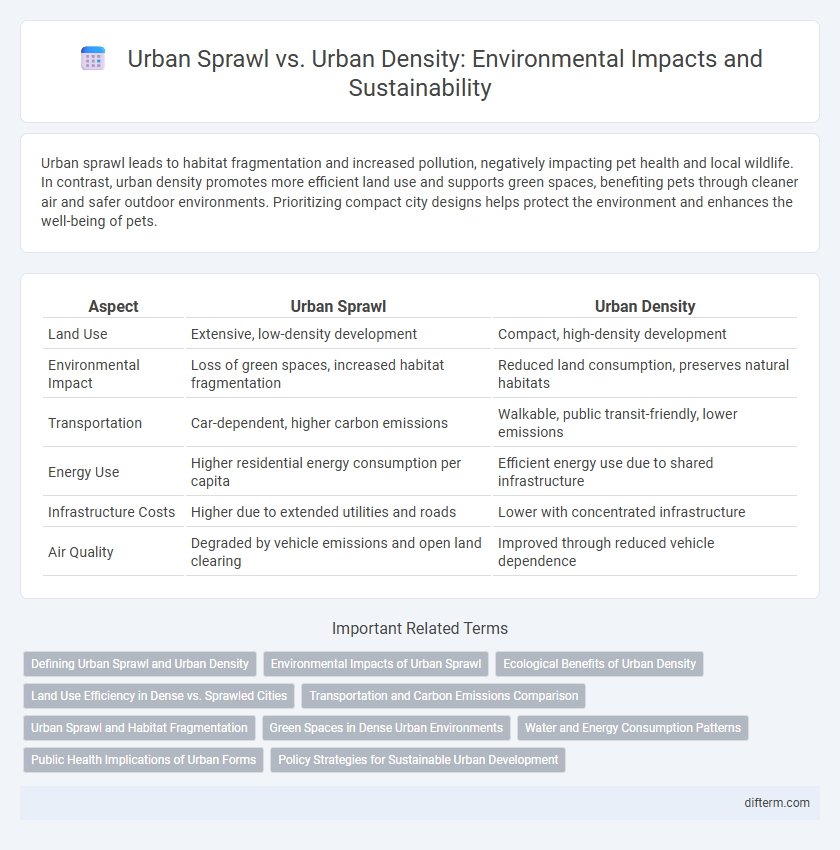Urban sprawl leads to habitat fragmentation and increased pollution, negatively impacting pet health and local wildlife. In contrast, urban density promotes more efficient land use and supports green spaces, benefiting pets through cleaner air and safer outdoor environments. Prioritizing compact city designs helps protect the environment and enhances the well-being of pets.
Table of Comparison
| Aspect | Urban Sprawl | Urban Density |
|---|---|---|
| Land Use | Extensive, low-density development | Compact, high-density development |
| Environmental Impact | Loss of green spaces, increased habitat fragmentation | Reduced land consumption, preserves natural habitats |
| Transportation | Car-dependent, higher carbon emissions | Walkable, public transit-friendly, lower emissions |
| Energy Use | Higher residential energy consumption per capita | Efficient energy use due to shared infrastructure |
| Infrastructure Costs | Higher due to extended utilities and roads | Lower with concentrated infrastructure |
| Air Quality | Degraded by vehicle emissions and open land clearing | Improved through reduced vehicle dependence |
Defining Urban Sprawl and Urban Density
Urban sprawl refers to the uncontrolled expansion of urban areas into peripheral rural land, characterized by low-density, car-dependent development and fragmented open spaces. Urban density, in contrast, emphasizes compact, high-density living environments that optimize land use through multi-story buildings and mixed-use developments. These contrasting patterns significantly impact resource consumption, transportation efficiency, and environmental sustainability within metropolitan regions.
Environmental Impacts of Urban Sprawl
Urban sprawl significantly increases carbon emissions due to dependence on automobiles and extended infrastructure networks. It leads to habitat fragmentation, reducing biodiversity and disrupting local ecosystems. Moreover, sprawling development exacerbates water runoff and pollution, contributing to environmental degradation and strain on natural resources.
Ecological Benefits of Urban Density
Urban density significantly reduces the ecological footprint by minimizing land consumption and preserving natural habitats, supporting biodiversity within metropolitan areas. Compact urban forms enable efficient public transportation systems, lowering greenhouse gas emissions and air pollution compared to sprawling suburban developments. High-density living also promotes energy-efficient building designs and reduces resource use per capita, advancing sustainable urban ecosystems.
Land Use Efficiency in Dense vs. Sprawled Cities
Dense urban areas maximize land use efficiency by accommodating more people and businesses within a smaller footprint, reducing the need for extensive infrastructure and preserving natural habitats. In contrast, urban sprawl spreads development over large areas, leading to higher land consumption, increased reliance on automobiles, and greater environmental degradation. Efficient land use in dense cities supports sustainable growth by minimizing habitat loss and lowering carbon emissions compared to sprawling metropolitan regions.
Transportation and Carbon Emissions Comparison
Urban density significantly reduces carbon emissions by promoting public transportation, walking, and cycling, minimizing reliance on personal vehicles. In contrast, urban sprawl increases transportation demand, leading to higher vehicle miles traveled (VMT) and elevated greenhouse gas emissions due to longer commutes. Efficient urban planning prioritizes compact development to lower transportation-related carbon footprints and improve air quality.
Urban Sprawl and Habitat Fragmentation
Urban sprawl causes significant habitat fragmentation by expanding low-density development into natural landscapes, leading to loss of biodiversity and disruption of ecosystems. This unchecked expansion increases impermeable surfaces, reduces green spaces, and isolates wildlife populations, making migration and reproduction more difficult. Managing urban growth through controlled density is crucial to preserving habitats and maintaining ecological balance.
Green Spaces in Dense Urban Environments
Green spaces in dense urban environments significantly mitigate the environmental impact of urban sprawl by providing essential ecosystems for biodiversity and improving air quality. Concentrated urban density allows for more efficient land use, preserving larger contiguous green areas that support temperature regulation and stormwater management. Integrating parks, community gardens, and green roofs within dense cities enhances residents' well-being while reducing the carbon footprint associated with sprawling developments.
Water and Energy Consumption Patterns
Urban sprawl significantly increases water and energy consumption due to extended infrastructure and reliance on private transportation. In contrast, urban density promotes efficient water use and reduces energy demand through shared resources and shorter travel distances. Studies show that compact cities can lower per capita water usage by up to 30% and energy consumption by nearly 50% compared to sprawling metropolitan areas.
Public Health Implications of Urban Forms
Urban sprawl increases air pollution and sedentary lifestyles, leading to higher rates of respiratory diseases, obesity, and cardiovascular conditions. In contrast, urban density promotes walkability, reduces car dependency, and improves access to healthcare facilities, enhancing overall public health outcomes. However, excessively dense environments may also contribute to mental health challenges and increased transmission of infectious diseases without adequate green space and infrastructure.
Policy Strategies for Sustainable Urban Development
Policy strategies for sustainable urban development emphasize controlling urban sprawl through zoning regulations that promote higher urban density and mixed-use development, reducing land consumption and preserving natural habitats. Implementing transit-oriented development (TOD) policies encourages public transportation use, lowers greenhouse gas emissions, and improves access to essential services in densely populated areas. Green infrastructure integration and inclusionary housing policies further enhance urban resilience, social equity, and environmental sustainability.
urban sprawl vs urban density Infographic

 difterm.com
difterm.com